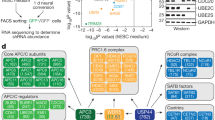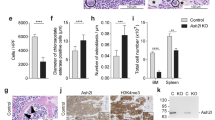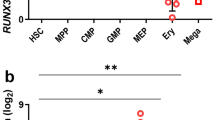Abstract
Hox gene products, initially characterized as master regulators of embryonic patterning, are also required for proper functioning of adult tissues. There is also a growing body of evidence that links Hox proteins to regulation of cellular proliferation/transformation. However, the underlying molecular mechanisms of Hox-associated transformation and tissue growth have yet to be elucidated. Using a well established model system for studying changes in cellular proliferation induced by Hoxb4, we show that AP-1 activity is markedly increased in Hoxb4-transduced cells due to significant upregulation of Jun-B and Fra-1 protein levels. Furthermore, we also show that the specific changes in AP-1 protein expression are necessary for the proliferation effects induced by Hoxb4, and that these changes converge to increase levels of cyclin D1, a known integrator of proliferation signals. Our observations thus link Hox gene products with key elements of the cell cycle machinery.
This is a preview of subscription content, access via your institution
Access options
Subscribe to this journal
Receive 50 print issues and online access
$259.00 per year
only $5.18 per issue
Buy this article
- Purchase on Springer Link
- Instant access to full article PDF
Prices may be subject to local taxes which are calculated during checkout






Similar content being viewed by others
References
Albanese C, Watanabe G, Johnson C, Eklund N, Dzuy V, Arnold A and Pestell RG. . 1995 J. Biol. Chem. 270: 23589–23597.
Amato SA, Nakajima K, Hirano T and Chiles TC. . 1996 J. Immunol. 154: 146–155.
Asahara H, Dutta S, Kao H-J, Evans RM and Monteminy RM. . 1999 Mol. Cell. Biol. 19: 8219–8225.
Bergers G, Graninger G, Braselmann S, Wrighton C and Busslinger M. . 1995 Mol. Cell. Biol. 15: 3748–3758.
Borrow J, Shearman AM, Stanton VP, Becher R, Collins T, Williams AJ, Dubé ID, Katz F, Kwong YL, Morris C, Ohyashiki K, Toyama K, Rowley J and Housman DE. . 1996 Nat. Genet. 12: 159–167.
Care A, Silvani A, Meccia E, Mattia G, Stoppacciaro A, Parmiani G, Peschle C and Colombo MP. . 1996 Mol. Cell. Biol. 16: 4842–4851.
Care A, Testa U, Bassani A, Tritarelli E, Montesoro E, Samoggia P, Cianetti L and Peschle C. . 1994 Mol. Cell. Biol. 14: 4872–4877.
Chariot A, Lint C, Chapelier M, Gielen J, Merville MP and Bours V. . 1999 Oncogene 18: 4007–4014.
Chen F and Capecchi MR. . 1999 Proc. Natl. Acad. Sci. USA 96: 541–546.
Cillo C. . 1994 Invasion Metastasis 14: 38–49.
Coffer P, de Jonge M, Mettouchi A, Binetruy B, Ghysdael J and Kruijer W. . 1994 Oncogene 9: 911–921.
De Vita G, Barba P, Odartchenko N, Givel JC, Freschi G, Bucciarelli G, Magli MC, Boncinelli E and Cillo C. . 1993 Eur. J. Cancer 29A: 887–893.
Friedmann Y, Daniel CA, Strickland P and Daniel CW. . 1994 Cancer Res. 54: 5981–5985.
Herber B, Truss, Beato M and Muller R. . 1994 Oncogene 9: 2105–2107.
Kovary K and Bravo R. . 1991 Mol. Cell. Biol. 11: 4466–4472.
Kroon E, Krosl J, Thorsteinsdottir U, Baban S, Buchberg AM and Sauvageau G. . 1998 EMBO J. 17: 3714–3725.
Krosl J, Baban S, Krosl G, Rozenfeld S, Largman C and Sauvageau G. . 1998 Oncogene 16: 3403–3412.
Krumlauf R. . 1994 Cell 78: 191–201.
Lallemand D, Spyrou G, Yaniv M and Pfarr CM. . 1997 Oncogene 14: 819–830.
Lawrence HJ, Helgason CD, Sauvageau G, Fong S, Izon DJ, Humphries RK and Largman C. . 1997 Blood 89: 1922–1930.
Lee W, Mitchell P and Tijan R. . 1987 Cell 49: 741–752.
Mamo A, Thorsteinsdottir U, Kroon E, Bijl J, Lawrence HJ, Largman C, Humphries RK and Sauvageau G. . 1999 Blood 96: (Suppl.1) 250a.
Mann RS and Chan SK. . 1996 Trends Genet. 12: 258–262.
McCarthy SA, Chen D, Yang BS, García E, Cherwinski SH, Chen XR, Klagsburg M, Hauser CA, Ostrowski MC and McMahon M. . 1997 Mol. Cell. Biol. 17: 2401–2412.
Mechta F, Lallemand D, Pfarr C and Yaniv M. . 1997 Oncogene 14: 837–847.
Nakamura T, Largaespada DA, Lee MP, Johnson LA, Ohyashiki K, Toyama K, Chen SJ, Willman CL, Chen IM, Feinberg AP, Jenkins NA, Copeland NG and Shaughnessy JD. . 1996 Nat. Genet. 12: 154–158.
Passegué E and Wagner FE. . 2000 EMBO J. 19: 2969–2979.
Quaranta MT, Petrini M, Tritarelli E, Samoggia P, Caré A, Bottero L, Testa U and Peschle C. . 1996 J. Immunol. 157: 2462–2469.
Salser SJ and Kenyon C. . 1994 Trends Genet. 10: 159–164.
Sauvageau G, Lansdorp PM, Eaves CJ, Hogge DE, Dragowska WH, Reid DS, Largman C, Lawrence HJ and Humphries RK. . 1994 Proc. Natl. Acad. Sci. USA 91: 12223–12227.
Sauvageau G, Thorsteinsdottir U, Eaves CJ, Lawrence HJ, Largman C, Lansdorp PM and Humphries RK. . 1995 Genes Dev. 9: 1753–1765.
Sauvageau G, Thorsteinsdottir U, Hough MR, Hugo P, Lawrence HJ, Largman C and Humphries RK. . 1997 Immunity 6: 13–22.
Schütte J, Viallet J, Nau M, Segal S, Fedorko J and Minna J. . 1989 Cell 59: 987–997.
Snowden AW and Perkins ND. . 1998 Biochem. Pharmacol. 55: 1947–1954.
Stelnicki EJ, Komuves L, Kwong A, Holmes D, Klein P, Rozenfeld S, Lawrence HJ, Adzick NS, Harrison M and Largman C. . 1998 J. Invest. Dermatol. 110: 110–115.
Vallone D, Battista S, Pierantoni GM, Fedele M, Casalino L, Santoro M, Viglietto G, Fusco A and Verde P. . 1997 EMBO J. 16: 5310–5321.
Yueh YG, Gardner DP and Kappen C. . 1998 Proc. Natl. Acad. Sci. USA 95: 9956–9961.
Zakany J and Duboule D. . 1996 Nature 384: 69–71.
Zappavigna V, Sartori D and Mavilio F. . 1994 Genes Dev. 8: 732–744.
Acknowledgements
This work was supported by a grant (#10435) from the National Cancer Institute of Canada (to G Sauvageau). The authors acknowledge Drs Corey Largman for the generous gift of Hoxb4 antiserum, Dr Keith R Humphries for providing the MSCV PGK EGFP vector, Dr Kevin McBride for critical discussions regarding biochemistry of AP-1 complex, and Nadine Mayotte for technical support. The support of Nathalie Tessier, head of the Flow Cytometry Department of the IRCM, is also acknowledged. J Krosl is a recipient of American Society for Hematology Scholarship, and G Sauvageau is a MRC clinician scientist.
Author information
Authors and Affiliations
Rights and permissions
About this article
Cite this article
Krosl, J., Sauvageau, G. AP-1 complex is effector of Hox-induced cellular proliferation and transformation. Oncogene 19, 5134–5141 (2000). https://doi.org/10.1038/sj.onc.1203897
Received:
Revised:
Accepted:
Published:
Issue Date:
DOI: https://doi.org/10.1038/sj.onc.1203897
Keywords
This article is cited by
-
The role of HOX genes in normal hematopoiesis and acute leukemia
Leukemia (2013)
-
Evidence for Hox and E2A–PBX1 collaboration in mouse T-cell leukemia
Oncogene (2008)
-
Deconstructing stem cell self-renewal: genetic insights into cell-cycle regulation
Nature Reviews Genetics (2008)
-
HOXB4 confers a constant rate of in vitro proliferation to transduced bone marrow cells
Oncogene (2005)
-
In vitro expansion of hematopoietic stem cells by recombinant TAT-HOXB4 protein
Nature Medicine (2003)



